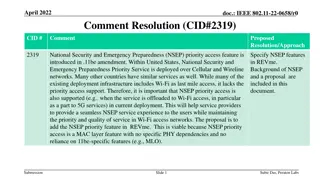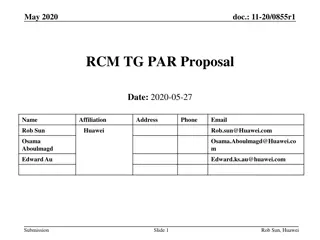IEEE 802.11-20/0021-00 Priority Access Support for NS/EP Services Overview
This document discusses the importance of priority access support in IEEE 802.11be for National Security and Emergency Preparedness (NS/EP) services. It outlines the need for standardized mechanisms to ensure priority services in WLAN networks during NS/EP events when cellular coverage is unavailable. The presentation covers existing IEEE 802.11 features for Emergency Services, highlights capabilities from 3GPP for NS/EP services, and identifies gaps in IEEE 802.11 support for NS/EP Priority Services.
Download Presentation

Please find below an Image/Link to download the presentation.
The content on the website is provided AS IS for your information and personal use only. It may not be sold, licensed, or shared on other websites without obtaining consent from the author. Download presentation by click this link. If you encounter any issues during the download, it is possible that the publisher has removed the file from their server.
E N D
Presentation Transcript
January 2020 doc.: IEEE 802.11-20/0021-00 Priority Access Support for NS/EP Services Date: 2020-01-11 Authors: Name Subir Das Affiliations Perspecta Labs Address 150 Mt. Airy Road, Basking Ridge, New Jersey, 07920, USA 150 Mt. Airy Road, Basking Ridge, New Jersey, 07920, USA 245 Murray Lane, Building 410 Washington, DC 20528-8510 245 Murray Lane, Building 410 Washington, DC 20528-8510 Phone 908 748 2483 email sdas@perspectalabs.com Kiran Rege Perspecta Labs 732 898 8420 krege@perspectalabs.com An Nguyen DHS/CISA/ECD +1 202-297-1817 an.p.nguyen@cisa.dhs.gov Frank Suraci DHS/CISA/ECD +1 703-307-4422 frank.suraci@cisa.dhs.gov Submission Slide 1 Subir Das, Perspecta Labs
January 2020 doc.: IEEE 802.11-20/0021-00 Overview Priority access support in IEEE 802.11be for National Security and Emergency Preparedness (NS/EP) Priority Services with additional applicability were presented in November 2019 [1] Objective Summary Wi-Fi access networks in scenarios where Wi-Fi access may be the only available access networks such as inside a building, airports, stadiums or places where there is no cellular radio coverage available during NS/EP events A standardized mechanism to support the NS/EP Priority Services in WLAN (a.k.a. Wi-Fi access) networks without requiring additional infrastructure Priority access in IEEE 802.11be would also be beneficial to other services ( e.g., Mission Critical Services used for Public Safety), and Critical Medical Applications) Submission Slide 2 Subir Das, Perspecta Labs
January 2020 doc.: IEEE 802.11-20/0021-00 Outline This presentation covers the following: Additional information based on November 2019 discussions Existing IEEE 802.11 features to support Emergency Services (e.g., E911 in US) NS/EP Priority Services are different than Emergency Services (e.g., E911 in US) Highlights capabilities that are defined in 3GPP (4G/5G) to support NS/EP Priority Services Identifies a few gaps and capabilities that are required for supporting NS/EP Priority Services in IEEE 802.11 Submission Slide 3 Subir Das, Perspecta Labs
January 2020 doc.: IEEE 802.11-20/0021-00 Emergency Service Support in IEEE 802.11 Support of Emergency calls (e.g., E911) as part of Interworking Service Support using a multi-layer solution approach [2] Multi-layer indicates that emergency services will be provided by protocols developed in part by other standard bodies (e.g., IETF, 3GPP ) A non-AP STA can signal to an AP STA that a call is an emergency call. The TSPEC (Traffic Specification) element used in a basic ADDTS (Add Traffic Stream) frame to request bandwidth can indicate priority using EBR (Expedited Bandwidth Request) It is the STA s responsibility to transmit the element in response to call signaling messages How this is done is outside the scope of the interworking service If WLAN is congested, then AP can deny TSPEC Submission Slide 4 Subir Das, Perspecta Labs
January 2020 doc.: IEEE 802.11-20/0021-00 Emergency Service Support in IEEE 802.11 Contd.. If AP is able to determine that the call is an emergency call, then it can invoke other options to admit the TSPEC request The standard does not describe what these other options are though EBR is optional in basic ADDTS Request/Response frame EBR is not defined in DMG (Directional Multi-Gigabit) ADDTS Request/Response frame The STA has the responsibility to confirm the availability of emergency services from the IEEE 802.11 network, including that the network is authorized for emergency services Submission Slide 5 Subir Das, Perspecta Labs
January 2020 doc.: IEEE 802.11-20/0021-00 NS/EP Priority Services NS/EP Priority Services are NOT the Emergency Services (e.g., E911 in US, 112, 110, 999, etc. in Europe) that are normally available to every citizen for emergency calling NS/EP Priority Services in US are government authorized services: Government Emergency Telecommunication Service (GETS), Wireless Priority Service (WPS) and Next Generation Network Priority Service Services enable authorized users to gain priority access to communication network resources in support of their NS/EP mission activities NS/EP Priority Services are deployed by the operators using commercial network infrastructure and enabled through global standards No unauthenticated and unauthorized user is permitted to use the NS/EP Priority Services Submission Slide 6 Subir Das, Perspecta Labs
January 2020 doc.: IEEE 802.11-20/0021-00 NS/EP Priority Services Support in 3GPP (4G/5G) 3GPP defines capabilities in support of NS/EP Priority Services (called Multimedia Priority Service (MPS) for 4G and 5G In particular, 5G provides the following capabilities for Priority Channel Access: Prioritized Physical Random Access Channel (P-PRACH): enables prioritized users to complete the Random Access procedure with lower latency Devices allowed to use P-PRACH parameters can ramp up their transmit power quickly and use smaller back-off intervals in case of collision over PRACH From 3GPP Release 16 onwards, MPS (NS/EP Priority Services in the U.S.) users will be allowed to use P-PRACH during initial access attempts Access barring: enables service providers, during congestion, to limit access to PRACH for some classes of users while exempting some other classes of users from access restrictions Access barring is announced on the basis of Access Identity (AI) and Access Category (AC) A special AI = 1 has been either assigned to NS/EP Priority Service users during registration or configured a priori in NS/EP Priority Service designated devices Enables service providers to exempt NS/EP Priority Service devices from access barring during congestion Submission Slide 7 Subir Das, Perspecta Labs
January 2020 doc.: IEEE 802.11-20/0021-00 NS/EP Priority Services Support in 5G Contd.. 5G provides the following capabilities for Priority link/data connection: Connection (a.k.a. Radio Resource Control (RRC)) Establishment Priority RRC Setup Request contains a field Establishment Cause NS/EP Priority Service subscribed devices set Establishment Cause = mps-PriorityAccess, that allows signaling messages during the initial attach procedure (e.g. Registration Request) as well as subsequent connectivity establishment procedures (e.g. PDU Session Establishment Request) to be treated with higher priority (mps: multimedia priority service = NS/EP Priority Service in 3GPP terminology) If network functions remember the nature of these devices, all subsequent signaling messages associated with these devices can be treated with higher priority Data link (a.k.a. PDU Session) Establishment Priority 5G associates two QoS parameters: 5QI (5G QoS Indicator) and ARP (Allocation and Retention Priority) 5QI contains a priority level that determines the relative priority with which user packets associated with a flow/session are handled; it may also be factored into routing decisions ARP determines the relative priority for admission control for flow/session establishment, and whether a flow/session can be released to accommodate a new higher priority one NS/EP devices can be allocated appropriate 5QI and ARP parameters so that they can obtain preferential treatment in flow/session setup and user data transport Submission Slide 8 Subir Das, Perspecta Labs
January 2020 doc.: IEEE 802.11-20/0021-00 QoS Mechanisms and Gaps in IEEE 802.11 IEEE 802.11 [1] defines four Access Categories (ACs) to give differential treatment to four traffic classes Voice, Video, Best effort and Background with Voice at the highest priority Priorities are implemented by configuring different Inter-Frame-Spaces (AIFSs) and back-off window limits STA can send QoS request via TSPEC and TCLAS elements in ADDTS frame STA may send TXOP requests using QoS Control field in QoS Data frame/Null frame Gaps: No mechanism is available to identify and provide differential treatment between STAs that request the TSPEC and TCLAS belonging to the same Access Category (e.g., AC_VO) Submission Slide 9 Subir Das, Perspecta Labs
January 2020 doc.: IEEE 802.11-20/0021-00 QoS Mechanisms and Gaps in IEEE 802.11 IEEE 802.11 [1] defines Intra-access category prioritization for stream classification in a non-AP STA or in an AP STA A non-AP STA may send Intra-AC Priority element to indicate the relative priorities of streams within an AC This element is optionally present in ADDTS Request, QoS Map or SCS Request frames User Priority(UP) subfield allows one to indicate the stream priority Gaps: No mechanism is available for prioritization between traffic streams belonging to the same Access Category that originate from different STAs (e.g., No means to differentiate NS/EP Priority Service traffic from other traffic in the same class) Submission Slide 10 Subir Das, Perspecta Labs
January 2020 doc.: IEEE 802.11-20/0021-00 QoS Mechanisms and Gaps in IEEE 802.11 IEEE 802.11 [1] recommends that channel access and subsequent signaling messages (e.g., Probe Request/Response, Association Request/Response) are carried as best effort (i.e., AC_BE) traffic It also recommends that admission control not be required for AC_BE and AC_BK However, it is recommended that any STA authenticated through an SSPN (Subscription Service Provider Network) interface use admission control for AC_VO and AC_VI traffic Gaps: No mechanism exists to admit only STAs belonging to certain users and provide differential treatment to messages during initial channel access and subsequent signaling during congestion Submission Slide 11 Subir Das, Perspecta Labs
January 2020 doc.: IEEE 802.11-20/0021-00 Capabilities Needed Need a mechanism, during network congestion, to limit access to the medium only to STAs that require higher priority access than other STAs (e.g., STAs that support NS/EP Priority Service users vs. STAs that do not) Need a mechanism so that messages carrying the identity of STAs requiring higher priority access can be admitted to the network with low latency during network congestion Need a mechanism so that non-AP STAs that have a higher priority than other STAs are able to request and are allowed to associate to the network Need a mechanism whereby AP STAs, during congestion, can grant traffic stream setup requests only from STAs with a higher priority than other STAs. The AP STAs should be able to make this distinction even when the requests are for traffic streams in the same Access Category Submission Slide 12 Subir Das, Perspecta Labs
January 2020 doc.: IEEE 802.11-20/0021-00 Summary In this presentation, we discussed the existing QoS features, identified the gaps and the capabilities that are needed to support the NS/EP Priority Services in IEEE 802.11 access networks NS/EP Priority Services in the US differ from Emergency calls (e.g., E911) in that they are limited to government-authorized users No mechanism is available to identify and provide differential treatment between STAs that belong to the same Access Category (e.g., AC_VO) No mechanism is available to prioritize streams between two non-AP STAs that belong to the same classification No mechanism is available during congestion to distinguish different classes of STAs attempting network attachment and to provide differential treatment during initial channel access and subsequent signaling Additional mechanism(s) is/are required to support the NS/EP Priority Service use case Submission Slide 13 Subir Das, Perspecta Labs
January 2020 doc.: IEEE 802.11-20/0021-00 References [1] 11-19-1901-01-00be-priority-access-support-in-ieee-802-11be-what-and-why.pptx [2] IEEE Std 802.11 -2016 [3] TS 38.300 NR; Overall description; Stage-2 (Release 15) [4] TS 38.331 NR; Radio Resource Control (RRC); Protocol specification (Release 15) [5] TS 38.321 NR; Medium Access Control (MAC) protocol specification (Release 15) [6] TS 24.501 Non-Access-Stratum (NAS) protocol for 5G System (5GS) (Release 15) [7] 3GPP TS 22.153: Technical Specification Group Services and System Aspects; Multimedia Priority Service (Release 8) [8] 3GPP TR 22.854: Technical Specification Group Services and System Aspects; Feasibility Study on Multimedia Priority Service - Phase 2 (Release 17) [9] ATIS-0100009: Overview of Standards in Support of Emergency Telecommunication Service (ETS) and ATIS-01000010: Support of Emergency Telecommunications Service (ETS) in IP Networks Submission Slide 14 Subir Das, Perspecta Labs
doc.: IEEE 802.11-20/0021-00 Straw Poll 1 Do you consider supporting that the 802.11be amendment shall define mechanism(s) in support of priority access to NS/EP Priority Service users non-AP STAs that enables the following: Allow to get access to the medium so that the initial signaling messages that carry the capabilities and parameters can be admitted and forwarded* Provide the capability to request higher priority for traffic specification than other STAs of the same Access Category (AC)* Provide the AP STAs to admit and grant the priority access for authorized STAs* *The mechanisms are TBD Y: N: A: Submission Slide 15 Abhishek P (Qualcomm), et. al.,























